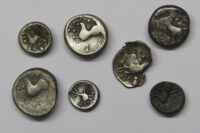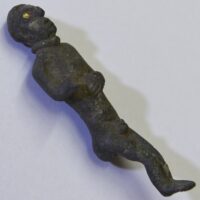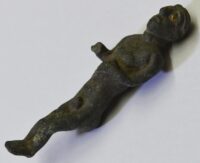 An Iron Age figurine of a man with golden eyes has been unearthed at Jánovce, northern Slovakia. The small bronze depicts a nude male wearing a very thick torque around his neck. The wide eye sockets are filled with gold that shine brightly in contrast with the dark patinated bronze. It was created by the Celtic La Tène culture which dominated the area until it was conquered by Rome in the 1st century B.C.
An Iron Age figurine of a man with golden eyes has been unearthed at Jánovce, northern Slovakia. The small bronze depicts a nude male wearing a very thick torque around his neck. The wide eye sockets are filled with gold that shine brightly in contrast with the dark patinated bronze. It was created by the Celtic La Tène culture which dominated the area until it was conquered by Rome in the 1st century B.C.
The town of Jánovce was founded in the Middle Ages — the first documented reference to it was written in 1312 — but it has been known since the 19th century that it was replete with archaeological material from the La Tène period. That has made it a target for looters and while there has been some archaeological excavation work in the area, Jánovce hasn’t been systematically excavated in a targeted fashion. A team of researchers from the Spiš Museum has been doing a preliminary archaeological survey to get an idea of the site’s potential. There was no excavation. All they did was collect objects churned up to the surface by agricultural activity, and over their work in the spring and fall of this year, they recovered more than 800 artifacts from prehistory to the modern era.
 Most of the finds were from the La Tène period overlapping with the Roman Iron Age (ca. 3rd – 1st century B.C.). The artifacts include Celtic coins, bronze fibulae, ceramics, glass beads and jewelry. These were luxury objects, and an enormous density of them has been found in the Spiš area, with a particularly high concentration in Jánovce. The richness of the finds indicate the Celtic settlements of the La Tène period were exceptionally affluent, far more so than in another regions of what is today Slovakia.
Most of the finds were from the La Tène period overlapping with the Roman Iron Age (ca. 3rd – 1st century B.C.). The artifacts include Celtic coins, bronze fibulae, ceramics, glass beads and jewelry. These were luxury objects, and an enormous density of them has been found in the Spiš area, with a particularly high concentration in Jánovce. The richness of the finds indicate the Celtic settlements of the La Tène period were exceptionally affluent, far more so than in another regions of what is today Slovakia.
 All of the objects recovered from the ploughed soils of Jánovce are now at the Spiš Museum where they are being documented, cleaned and conserved. Aided by experts from the Department of Archeology, Faculty of Arts, University of Constantine the Philosopher in Nitra, the museum plans to put some of the finds on display next year in a new exhibition. The golden-eyed figurine will be the foremost among them.
All of the objects recovered from the ploughed soils of Jánovce are now at the Spiš Museum where they are being documented, cleaned and conserved. Aided by experts from the Department of Archeology, Faculty of Arts, University of Constantine the Philosopher in Nitra, the museum plans to put some of the finds on display next year in a new exhibition. The golden-eyed figurine will be the foremost among them.


The golden-eyed semi-nude bronze dude is remarkably tiny, and he was presumably mounted on a bronze vessel, or maybe on something made from wood. It is hard to tell from the pictures, though, if he –in addition to the torque– wore at least some sort of hat.
The guy that was buried in the fifth century BC in the Glauberg main tumulus, for example, wore a ‘leaf cor*na’, almost like mickey-mouse ears, i.e. a stuffed wire construction with leather cap, as depicted in his life-sized sand stone from the top of his burial mound, cf.:
wikimedia.org/wikipedia/commons/0/06/Keltenf%C3%BCrst_Glauberg_vorne_rechts_1.JPG
The same ..‘leaf cor*na’ also appears on the so-called Pfalzfelder Säule (Pfalzfeld column) in the Rheinisches Landesmuseum in Bonn and on a bronze vessel from a female tumulus, i.e. with a female body, in Reinheim.
All the coins depict variations of the same motif, anyone know the meaning or significance of the design?
Not really, and I am no expert here. The designs were often copied from Greek coins, and really a lot of ‘keltic’ coins seem to have what appears to be a horse and sometimes the head of a ruler on the flip side, cf. this one:
———
upload.wikimedia.org/wikipedia/commons/b/b8/001-corinth-2.jpg
———
The ‘Δ’ appear to be the hoofs, while the ‘ί’ seem to be something else. What might look like some sort of inscription, though, is probably not what it seems, even if the use of Greek letters was –not only according to Caesar– quite common among those ‘Kelts’.
One aspect is regular trade with the Mediterranean world in the first millennium BC, but another is also warfare. One ‘Brennus’, for example, fought the ‘Battle of the Allia’ in 390 BC and then sacked Rome, while another hundred years later tried to cash in the treasures of the Oracle of Delphi in Greece.
The tiny figurine looks like a sacrificial victim, actually. His eyes are bugged out, his mouth is open and his cheeks are enlarged, as if he had been garroted by the torque.
Of course, a torque wont garrote anyone, but it might well be that the torque is no torque at all, or the whole thing was indeed part of a torque (in which case there might be another bronze dude out there). Thus, it would be interesting if his buttocks were possibly soldered onto something else.
To give an example, the massive golden torque from the main Glauberg tumulus, the one that he is also wearing on his sand stone statue, features indeed what appears to be two sacrificial victims (i.e. on each side of the three conical studs), even the size is comparable:
——————
upload.wikimedia.org/wikipedia/commons/b/b5/Gold_torque_2.jpg